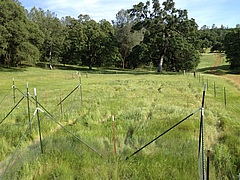PNAS paper: Insight into the "black box" of soil

One of the grasland locations. Here in US state of California (Photo: Stan Harpole)
Note for the media: Use of the pictures provided by iDiv is permitted for reports related to this media release only, and under the condition that credit is given to the picture originator.
Worldwide human activities have resulted in large increases in the availability of nutrients in ecosystems. In a recent study scientists from the US, Europe and Australia – including
Stan Harpole, Professor for Physiological Diversity at iDiv – published new results of the relationships between soil and plant communities in the renowned journal PNAS. The collaboration included researchers from 25 Nutrient Network (
NutNet) sites. Soil samples from around the world were analysed by Jonathan Leff and Noah Fierer at the University of Colorado using microbial sequencing and meta-genomic analysis. “We designed the NutNet as a globally distributed experiment to test multiple nutrient limitation of grassland plants”, says Stan Harpole. “Extending ecological theory to soil microbes is really challenging but the new genomic tools available are starting to open up that soil
black box.” One of the results: The responses of soil microbes are actually similar to what the scientists see in plant communities, suggesting that the theory they have for plants can be extended to soil microbes. Stan Harpole: “In fact, we show that changes in microbial composition tracked changes in plant composition when we added nutrients.”
To the paper on
pnas.org
